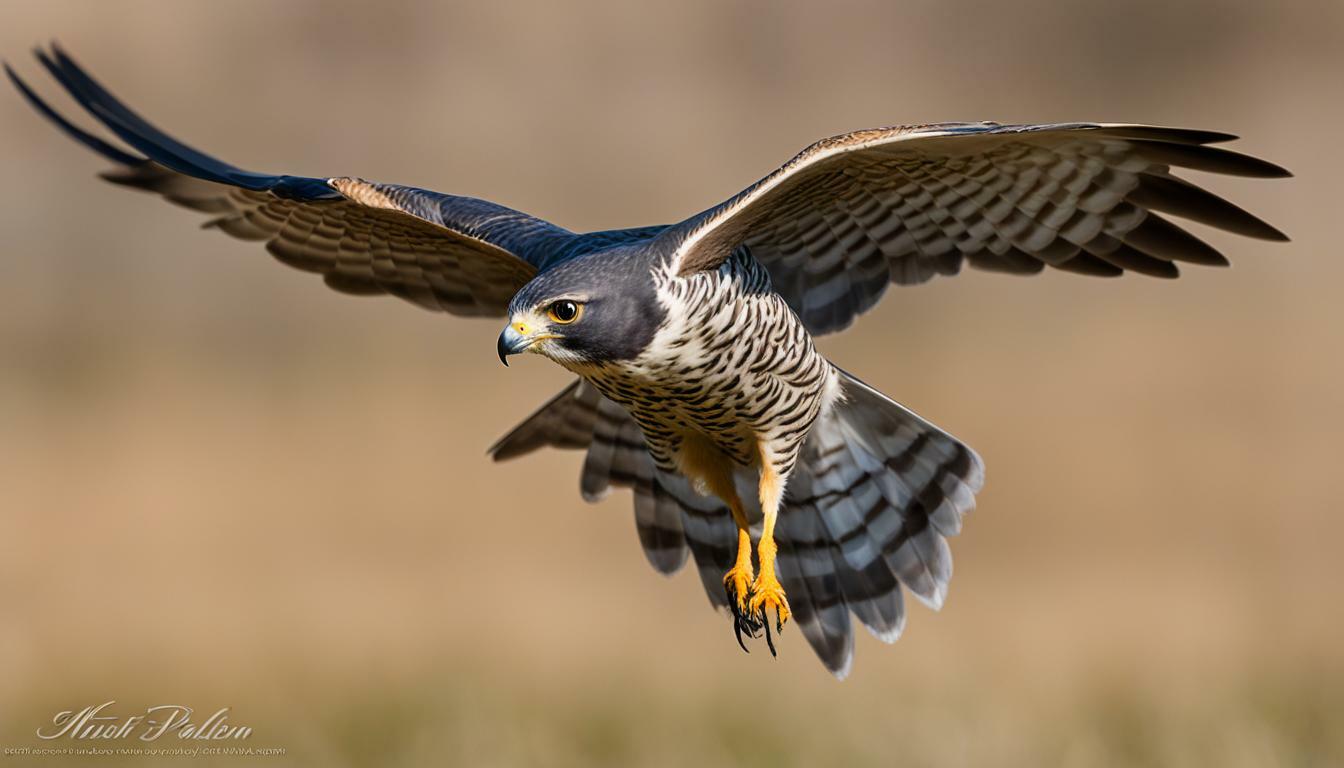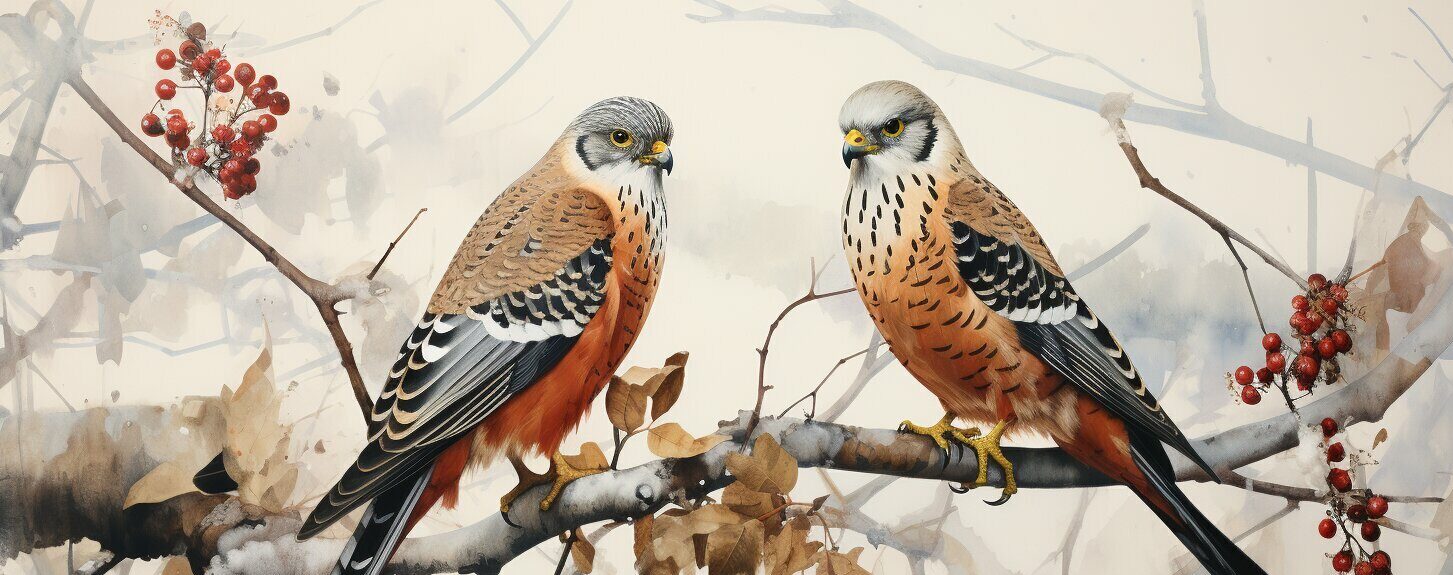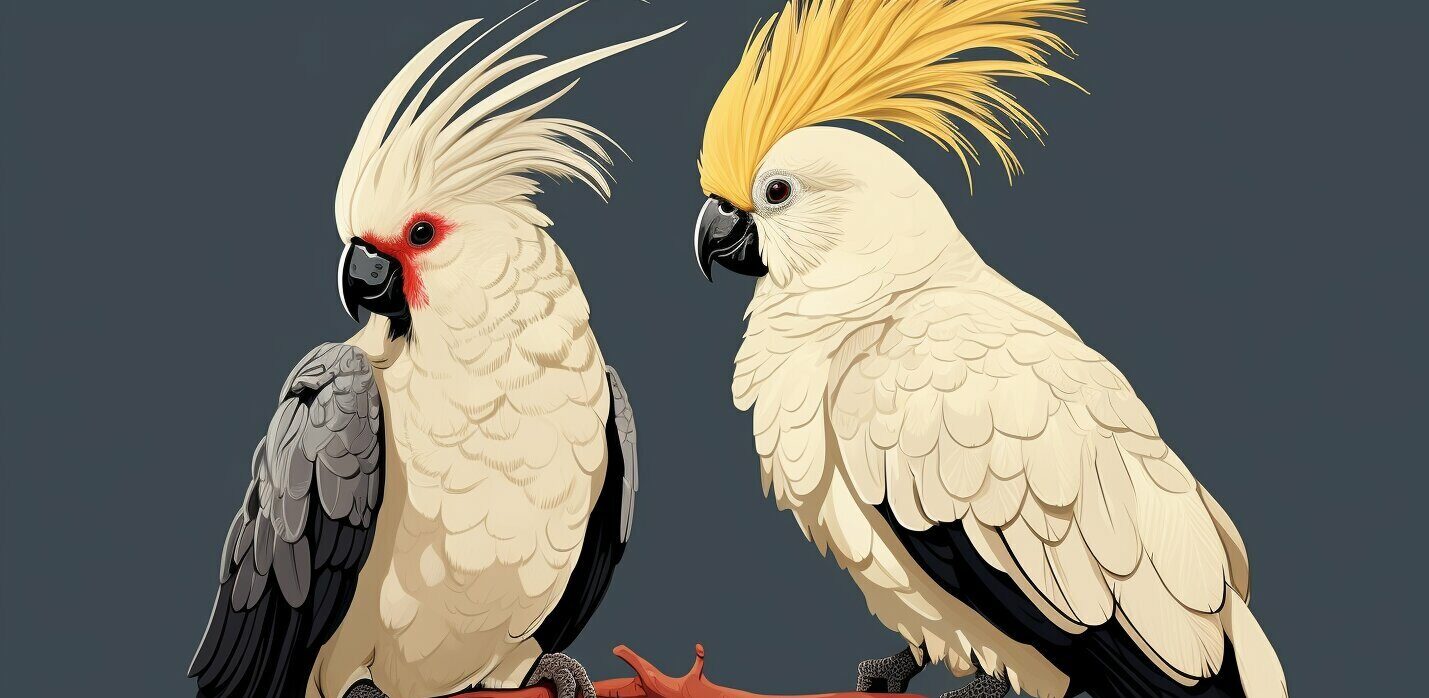Merlins and Falcons are both types of raptors, but they have distinct characteristics that set them apart. Merlins are smaller and more agile, perfect for hunting in boreal forests. Peregrine falcons, on the other hand, are larger and known for their incredible speed, diving at speeds of over 240 mph. In terms of appearance, peregrines have a darker head and back, while merlins have a lighter, blue head and back. Peregrines have a prominent mustache stripe on their face, while merlins have a faint, pale mustache stripe. They also differ in their hunting habits. Merlins hunt by flying fast and low to flush out small birds, while peregrines prefer to hunt medium-large birds in the open sky. In falconry, both merlins and peregrines are highly prized. Merlins were popular in medieval times, while peregrines have been used for hunting for over 3000 years. Both species have adapted well to living in urban environments and their populations have been increasing thanks to conservation efforts. Overall, merlins and peregrines are glorious and powerful birds with their own unique characteristics.
Key Takeaways:
- Merlins are smaller and more agile, while peregrine falcons are larger and faster.
- Peregrines have a darker head and back, while merlins have a lighter, blue head and back.
- Merlins hunt by flying fast and low, while peregrines prefer hunting in the open sky.
- Both merlins and peregrines have a long history in falconry.
- Both species have adapted well to urban environments and their populations are increasing.
Physical Characteristics
When comparing Merlins and Falcons, their physical characteristics play a significant role in distinguishing between the two species. Merlins are smaller in size, measuring around 25-30 centimeters in length, while Falcons are larger, with lengths ranging from 30-50 centimeters. Additionally, Merlins have a lighter, blue head and back, providing excellent camouflage in their natural habitats, such as boreal forests. On the other hand, Falcons have a darker head and back, with a prominent mustache stripe on their face.
One of the most notable features of Falcons is their incredible speed, making them the fastest birds in the world. Peregrine Falcons, a type of Falcon species, are known for their remarkable diving abilities, reaching speeds of over 240 mph during their hunting pursuits. This impressive speed allows them to catch their prey, often medium-large birds, in the open sky. In contrast, Merlins rely on their agility and speed to hunt small birds. These differences in hunting strategies are reflected in their physical attributes.
It is also worth mentioning that Falcons have long, pointed wings, which enable them to soar effortlessly through the sky. This wing structure, combined with their powerful flight muscles, allows Falcons to execute their swift and precise aerial maneuvers. On the other hand, Merlins have shorter, rounded wings, which enhance their maneuverability in densely wooded areas. This adaptation enables them to swiftly navigate through the trees, surprising their prey with quick and unexpected strikes.
Table: A Comparison of Physical Characteristics of Merlins and Falcons
| Merlins | Falcons | |
|---|---|---|
| Size | 25-30 centimeters | 30-50 centimeters |
| Head and Back Color | Lighter blue | Darker |
| Mustache Stripe | Faint, pale | Prominent |
| Wing Structure | Shorter, rounded | Long, pointed |
| Hunting Behavior | Fast and low to flush out small birds | Dive at high speeds to catch medium-large birds |
Size and Agility
Merlins and Falcons differ in size and agility, which impacts their hunting techniques and success rates. Merlins are smaller birds, measuring around 10-13 inches in length, while Falcons, particularly peregrine falcons, are larger with a length of 14-19 inches. This size difference gives merlins an advantage in maneuverability, allowing them to navigate through dense forests and chase their prey with precision. Falcons, on the other hand, use their larger size to their advantage, enabling them to dive at incredible speeds to catch their prey.
When it comes to agility, merlins are known for their swift and acrobatic flight. They are skilled at flying low to the ground and can quickly change direction in pursuit of small birds. This agility allows them to flush out their prey and catch it off guard. Falcons, particularly peregrines, are renowned for their unparalleled speed. They are capable of diving at speeds of over 240 mph, making them the fastest birds in the animal kingdom. This incredible speed helps them to successfully hunt medium-sized to large birds in open skies.
Size Comparison:
| Species | Length |
|---|---|
| Merlin | 10-13 inches |
| Falcon (Peregrine) | 14-19 inches |
In summary, merlins and falcons have distinct size and agility differences that shape their hunting methods and success rates. While merlins excel in their nimbleness and specialized flight techniques for hunting in forested areas, falcons, especially peregrines, utilize their larger size and incredible speed for hunting in open spaces. Both species showcase remarkable adaptations that contribute to their status as magnificent birds of prey.
Hunting Habits
While both Merlins and Falcons are skilled predators, their hunting habits vary significantly. Merlins, with their smaller size and agility, are adept at hunting in dense forests, where they fly fast and low to flush out small birds from their hiding places. They use their quick maneuverability and sharp talons to capture their prey, usually small songbirds like sparrows and finches. Merlins are known for their swift and stealthy hunting style, relying on surprise and speed to secure a meal.
Falcons, on the other hand, have a different approach to hunting. Peregrine falcons, in particular, are renowned for their incredible speed and aerial prowess. They are often seen soaring high in the sky, scanning the open areas for medium to large birds as their preferred prey, such as pigeons and ducks. Once a target is spotted, falcons initiate a breathtaking dive, called a stoop, reaching speeds of over 240 miles per hour. This high-speed dive allows them to strike their prey with incredible force, incapacitating them instantly.
It’s fascinating to observe how these two raptor species have evolved distinct hunting strategies based on their size, environment, and prey preferences. While Merlins rely on their agility and forest hunting skills, Falcons capitalize on their speed and aerial hunting prowess. Both methods have proven to be highly successful, highlighting the adaptability and efficiency of these magnificent birds of prey.
| Merlins | Falcons |
|---|---|
| Fly fast and low in dense forests | Soar high in the sky |
| Flush out small birds from hiding places | Scan the open areas for medium to large birds |
| Hunt small songbirds | Prey on pigeons and ducks |
| Swift and stealthy hunting style | High-speed dive (stoop) reaching speeds over 240 mph |
Adaptability to Urban Environments
Merlins and Falcons have shown remarkable adaptability to urban environments, making them a common sight in cities worldwide. These majestic birds have managed to thrive amidst the concrete jungles, finding new hunting grounds and nesting sites in the midst of human habitation.
Merlins, with their smaller size and agility, have proven to be adept at navigating the urban landscape. They have been known to make use of tall buildings and skyscrapers as perches, scanning the streets below for potential prey. Their quick and nimble flight allows them to navigate through tight spaces, making them well-suited to the confined urban environment.
Falcons, on the other hand, have made the skies of cities their hunting grounds. They take advantage of the open spaces and high vantage points to search for their prey. Peregrine falcons, in particular, have been observed diving from great heights to capture their target, a breathtaking sight that can be witnessed in many urban areas.
| Merlins | Falcons |
|---|---|
| Small size and agility | Large size and incredible speed |
| Blue head and back | Darker head and back |
| Faint, pale mustache stripe | Prominent mustache stripe |
| Flush out small birds | Hunt medium-large birds |
Both Merlins and Falcons have successfully adapted to the challenges posed by urban environments. Their presence not only adds beauty to our cities but also serves as a reminder of the resilience and adaptability of nature in the face of human development.
Historical Significance
Merlins and Falcons have played important roles in human history, with both species being highly prized for falconry. These majestic birds have been used for hunting for centuries, showcasing their incredible hunting skills and their bond with humans.
In medieval times, Merlins were especially popular in falconry. Their small size and agile nature made them ideal for hunting small game in the dense forests. The falconers of the past valued their quickness and ability to maneuver through the trees, making them valuable assets in the pursuit of game.
Peregrine Falcons, on the other hand, have a long and storied history in falconry. Known for their incredible speed and aerial prowess, they have been used for hunting for over 3000 years. Falcons were highly prized by kings and nobles, as their ability to dive at astonishing speeds made them formidable hunters in open skies.
Throughout history, both Merlins and Falcons have been trained and used by falconers to assist in hunting expeditions, showcasing the unique bond between humans and these magnificent creatures. Their historical significance in falconry cannot be understated, as they have been admired and celebrated for their hunting prowess and beauty for centuries.
Conservation Efforts and Population Increase
Thanks to dedicated conservation efforts, the populations of Merlins and Falcons have been on the rise in recent years. These magnificent birds have faced numerous challenges, including habitat loss, hunting, and the use of pesticides. However, through collaborative initiatives and protective measures, their numbers have started to rebound.
Conservation organizations have played a crucial role in monitoring and protecting Merlin and Falcon populations. By conducting research and implementing conservation programs, these organizations have been able to identify the specific needs of these raptors and take steps to address them.
Efforts to conserve Merlins and Falcons have focused on various aspects, including habitat preservation, captive breeding and release programs, and public education. Protected areas have been established to safeguard crucial nesting and foraging sites for these birds. Additionally, breeding programs have been successful in maintaining genetic diversity and reintroducing these raptors to suitable habitats.
Public awareness and education programs have also played a vital role in promoting the conservation of Merlins and Falcons. By increasing understanding and appreciation for these species, people are inspired to become actively involved in their protection. This can range from supporting conservation organizations financially to participating in citizen science projects that monitor raptor populations.
| Type of Conservation Effort | Description |
|---|---|
| Habitat Preservation | Establishment of protected areas to safeguard nesting and foraging sites. |
| Captive Breeding and Release Programs | Breeding Merlins and Falcons in captivity to maintain genetic diversity and reintroduce them to suitable habitats. |
| Public Education | Raising awareness and promoting conservation through educational programs and initiatives. |
“Conservation is a collective effort that requires the participation of individuals, communities, and governments. Together, we can ensure a brighter future for both Merlins and Falcons, allowing these majestic birds to continue soaring across our skies.”
Thanks to these combined efforts, the populations of Merlins and Falcons have shown signs of recovery and increase. However, continued vigilance and ongoing conservation initiatives are essential to maintain and further improve their numbers. By working together, we can strive to protect and preserve these remarkable raptors for future generations to admire and cherish.
Conclusion
In conclusion, Merlins and Falcons are magnificent birds with distinct differences in behavior, size, and hunting techniques.
Merlins, with their smaller size and agility, are perfectly suited for hunting in boreal forests. They are known for their ability to fly fast and low, flushing out small birds as their prey. In contrast, Falcons, particularly the Peregrine Falcon, are larger and renowned for their incredible speed. They are the fastest birds in the world, capable of diving at speeds exceeding 240 mph.
When it comes to appearance, Peregrine Falcons have a darker head and back, while Merlins have a lighter, blueish head and back. Peregrines also boast a prominent mustache stripe on their face, adding to their distinctive features. On the other hand, Merlins have a faint, pale mustache stripe.
In terms of hunting habits, Merlins and Falcons have their own preferred strategies. Merlins rely on their speed and agility to quickly catch smaller birds, while Falcons, especially Peregrines, prefer to hunt medium to large-sized birds in the open sky. These differences in hunting techniques showcase the remarkable adaptations of these birds to their respective environments.
Both Merlins and Falcons have played significant roles in human history, particularly in the realm of falconry. Merlins were highly valued during medieval times, while Falcons, such as the Peregrine Falcon, have been used for hunting for over 3000 years. These birds have captured the imagination of humans throughout the ages with their grace, power, and hunting prowess.
Interestingly, both Merlins and Falcons have successfully adapted to living in urban environments. Their populations have been increasing, thanks to conservation efforts aimed at protecting these magnificent birds. Their ability to thrive amidst the concrete jungles of cities is a testament to their resilience and adaptability.
FAQ
Q: What are the key differences between Merlins and Falcons?
A: Merlins are smaller and more agile, while Falcons are larger and known for their incredible speed.
Q: How do Merlins and Falcons differ in appearance?
A: Peregrine falcons have a darker head and back, while Merlins have a lighter, blue head and back. Peregrines also have a prominent mustache stripe on their face, while Merlins have a faint, pale mustache stripe.
Q: What are the hunting habits of Merlins and Falcons?
A: Merlins hunt by flying fast and low to flush out small birds, while Peregrine falcons prefer to hunt medium-large birds in the open sky.
Q: How well have Merlins and Falcons adapted to living in urban environments?
A: Both Merlins and Falcons have adapted well to urban environments and their populations have been increasing thanks to conservation efforts.
Q: What is the historical significance of Merlins and Falcons?
A: Merlins were popular in medieval times, while Falcons have been used for hunting for over 3000 years.
Q: How have conservation efforts impacted the populations of Merlins and Falcons?
A: Conservation efforts have led to an increase in the populations of both Merlins and Falcons.
 Skip to main content
Skip to main content


